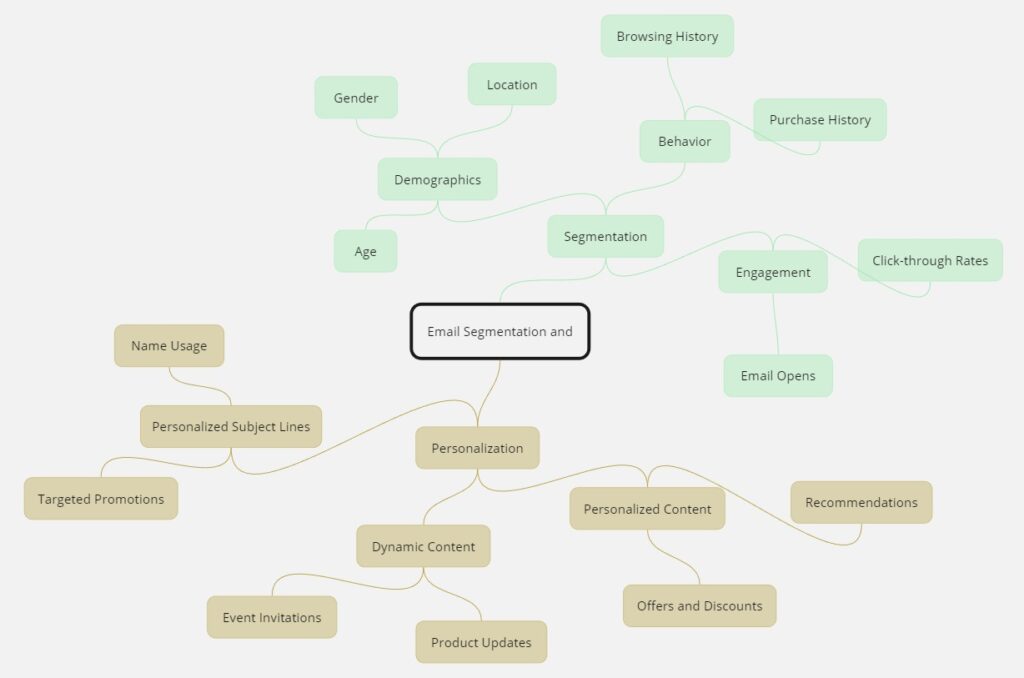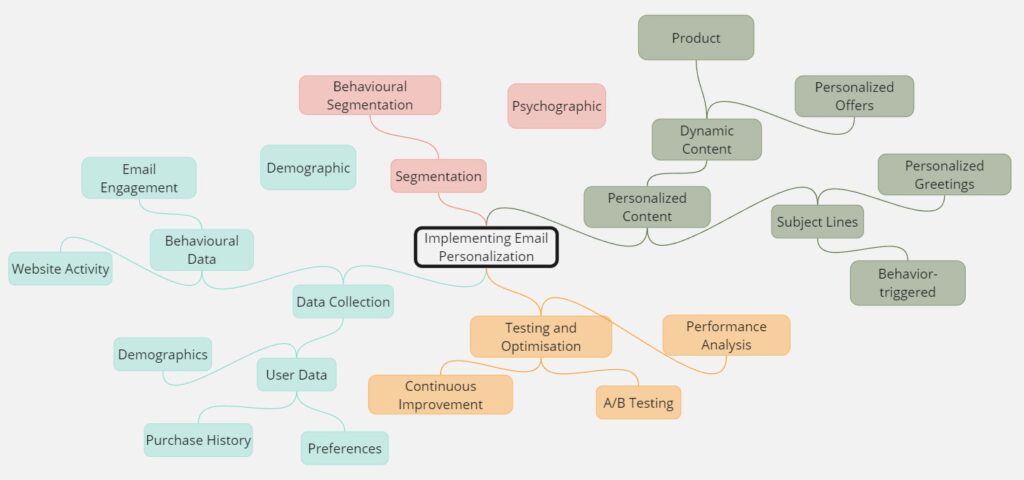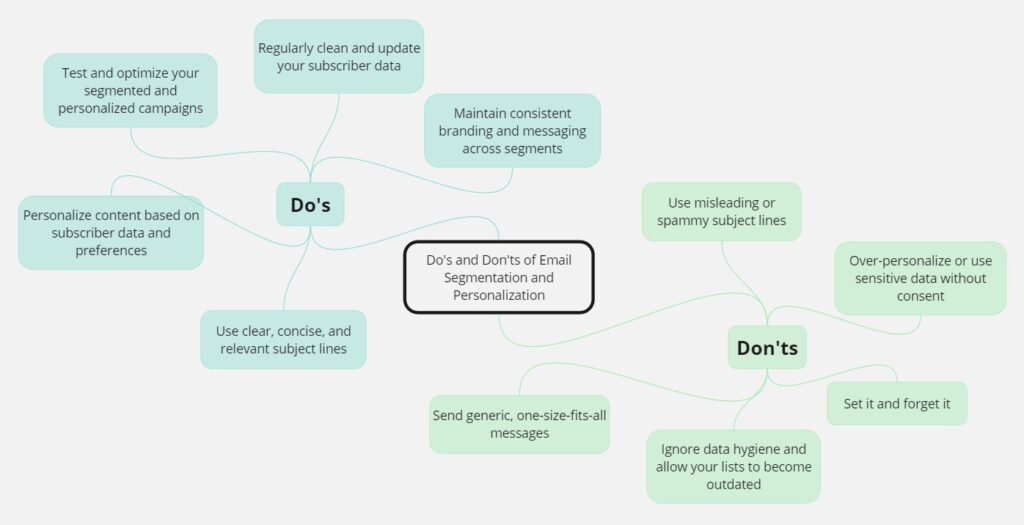Email Segmentation and Personalization: Unlocking the Power of Targeted Campaigns

In today’s digital landscape, email marketing remains one of the most effective ways to reach and engage your audience. However, with countless emails flooding inboxes daily, cutting through the noise and delivering content that resonates with your subscribers is essential. This is where email segmentation and personalization come into play.
By understanding and implementing these powerful strategies, you can:
- Improve open and click-through rates
- Enhance customer engagement and loyalty
- Increase conversion rates and revenue
- Provide a more tailored and satisfying customer experience
In this comprehensive guide, we’ll explore the world of email segmentation and personalization, exploring their definitions, benefits, and best practices. Whether you’re a seasoned marketer or just starting out, this article will equip you with the knowledge and tools needed to create highly targeted and effective email campaigns that drive results.
So, let’s embark on this journey together and unlock the full potential of your email marketing efforts!
Understanding Email Segmentation

What is Email Segmentation?
Email segmentation is the process of dividing your email list into smaller, more focused groups based on specific criteria. By creating these targeted segments, you can deliver more relevant and personalized content to your subscribers, ultimately leading to better engagement and conversions.
Definition and Basics
At its core, email segmentation involves:
- Collecting data on your subscribers’ demographics, interests, behaviour, and preferences
- Analyzing this data to identify patterns and commonalities
- Grouping subscribers with similar characteristics into distinct segments
- Tailoring your email content and offers to each segment’s specific needs and desires
Historical Context and Evolution
Email segmentation has advanced greatly since the early days of email marketing. Initially, marketers would send generic, one-size-fits-all messages to their entire list. However, as technology advanced and consumer expectations grew, the need for more targeted approaches became evident.
Today, email segmentation has evolved into a highly refined practice thanks to sophisticated marketing automation tools and data analytics. Marketers can now create granular segments based on various factors, enabling them to deliver increasingly personalized and effective campaigns.
Benefits of Email Segmentation
Implementing email segmentation can yield significant benefits for your business, including:
Improved Open and Click-Through Rates
By sending targeted content to specific segments, you’re more likely to capture your subscribers’ attention and encourage them to engage with your emails. Studies have shown that segmented campaigns can lead to 14.31% higher open rates and 100.95% higher click-through rates than non-segmented campaigns.
Enhanced Customer Engagement
When you deliver content that aligns with your subscribers’ interests and needs, they’re more likely to feel valued and connected to your brand. This increased engagement can foster long-term relationships and loyalty, ultimately leading to higher customer retention rates.
Increased Conversion Rates
Segmented email campaigns are more effective at driving conversions. They present subscribers with offers and content that are directly relevant to their needs and stage in the buyer’s journey. You can significantly boost your conversion rates and revenue by targeting the right people with the right message at the right time.
Common Segmentation Strategies
To create effective email segments, you can use various strategies based on different types of data:
Demographic Segmentation
Divide your list based on demographic information such as:
- Age
- Gender
- Income level
- Education
- Occupation
Geographic Segmentation
Group subscribers based on their location, such as:
- Country
- Region
- City
- Time zone
- Climate
Behavioural Segmentation
Segment your list based on subscribers’ actions and interactions with your brand, such as:
- Purchase history
- Website browsing behaviour
- Email engagement (opens, clicks, etc.)
- Abandoned cart status
Psychographic Segmentation
Create segments based on subscribers’ values, interests, and lifestyle preferences, such as:
- Personality traits
- Hobbies and interests
- Values and beliefs
- Attitudes and opinions
Combining these segmentation strategies allows you to create highly targeted and effective email campaigns that resonate with your audience and drive meaningful results for your business.
Implementing Email Segmentation
Now that you understand the basics and benefits of email segmentation, let’s explore how to implement it.
Collecting and Analyzing Data
The foundation of effective email segmentation lies in the quality and quantity of data you collect about your subscribers.
Data Collection Methods
There are several ways to gather valuable information about your subscribers:
- Sign-up forms: Include fields for relevant demographic and preference data when subscribers join your email list.
- Surveys and quizzes: Send periodic surveys or quizzes to gain insights into your subscribers’ interests, challenges, and preferences.
- Website tracking: Use analytics tools to monitor how subscribers interact with your website, such as pages visited and products viewed.
- Purchase history: Analyze subscribers’ purchase data to identify patterns and preferences.
- Email engagement: Track how subscribers engage with your emails, including opens, clicks, and conversions.
Tools and Software for Segmentation
To streamline the segmentation process, consider using the following tools and software:
- Email marketing platforms: Many email marketing services, such as Nimbl Mail, Mailchimp, Campaign Monitor, and Constant Contact, offer built-in segmentation features.
- Customer Relationship Management (CRM) systems: CRM platforms like Salesforce, HubSpot, and Zoho can help you manage and analyze customer data for segmentation purposes.
- Data analytics tools: Tools like Google Analytics, Mixpanel, and Kissmetrics provide valuable insights into subscriber behaviour and preferences.
Best Practices for Data Management
To ensure the effectiveness and integrity of your email segmentation efforts, follow these best practices for data management:
- Regularly update and clean your database: Remove inactive subscribers and ensure your data is accurate and up-to-date.
- Use progressive profiling: Gradually collect more information about your subscribers over time rather than overwhelming them with long sign-up forms.
- Comply with privacy regulations: Ensure your data collection and usage practices align with regulations like GDPR and CCPA.
- Integrate data from multiple sources: Combine data from various touchpoints to create a comprehensive view of your subscribers.
Creating Effective Segments
Once you have collected and analyzed your subscriber data, creating targeted segments is time.
Criteria for Segmenting Your Audience
When defining your segments, consider the following criteria:
- Relevance: Ensure that your segments are based on criteria that are relevant to your business and marketing goals.
- Measurability: Choose segmentation criteria that can be easily measured and tracked.
- Actionability: Create segments that enable you to take specific, targeted actions to engage and convert subscribers.
- Stability: Aim for relatively stable segments over time while allowing for flexibility as subscribers’ preferences and behaviours change.
Examples of Successful Segmentation
To inspire your own segmentation efforts, consider these examples of successful segmentation:
- E-commerce: Segment subscribers based on their purchase history, such as product categories, average order value, or purchase frequency.
- B2B: Divide your list based on company size, industry, or job title to deliver content tailored to each segment’s specific needs and challenges.
- Non-profit: Segment donors based on their giving history, volunteer status, or areas of interest to create targeted fundraising and engagement campaigns.
By implementing these segmentation strategies and best practices, you can create highly effective email campaigns that drive engagement, conversions, and long-term customer loyalty.
Understanding Email Personalization
While email segmentation focuses on dividing your list into targeted groups, email personalization takes it a step further by tailoring your content to individual subscribers.
What is Email Personalization?
Email personalization is the practice of creating customized email experiences for individual subscribers based on their unique characteristics, preferences, and behaviours. By leveraging subscriber data, you can deliver highly relevant and engaging content that resonates personally.
Definition and Basics
At its core, email personalization involves:
- Collecting and analyzing subscriber data to gain insights into their individual preferences and behaviors
- Using this data to create dynamic, customized content that speaks directly to each subscriber
- Delivering personalized emails that foster deeper connections and drive specific actions
Historical Context and Evolution
Like email segmentation, email personalization has evolved significantly over the years. In the early days of email marketing, personalization was limited to basic tactics like inserting a subscriber’s name in the subject line or greeting.
However, with the advent of advanced marketing technologies and data analytics, email personalization has become increasingly sophisticated. Today, marketers can create highly individualized email experiences based on various data points, from browsing behaviour and purchase history to real-time location and device usage.
Benefits of Email Personalization
Implementing email personalization can provide numerous benefits for your business, including:
Enhanced Customer Experience
By delivering content that is tailored to each subscriber’s unique needs and interests, you can create a more engaging and satisfying email experience. Epsilon research found that 80% of consumers are more likely to make a purchase from a brand that offers personalized experiences.
Increased Customer Loyalty
When subscribers feel that your emails are genuinely relevant and valuable to them, they are more likely to develop a strong affinity for your brand. This increased loyalty can lead to higher retention rates, frequent purchases, and positive word-of-mouth referrals.
Higher Revenue and ROI
Personalized emails have been shown to generate significant revenue and ROI for businesses. Experian says personalized emails deliver 6 times higher transaction rates than non-personalized emails. By presenting subscribers with targeted offers and content, you can drive more conversions and maximize the value of each email sent.
Common Personalization Strategies
To create personalized email experiences, consider using the following strategies:
Personalized Subject Lines
Incorporate subscriber-specific information, such as their name or recent actions, into your email subject lines to capture their attention and increase open rates.
| Subject Line | Personalization Element |
|---|---|
| “John, your exclusive offer awaits!” | First name |
| “Complete your order, Sarah!” | Abandoned cart reminder |
| “New arrivals perfect for your next hiking adventure!” | Interest-based |
Dynamic Content and Recommendations
Use subscriber data to dynamically display content and product recommendations that align with their individual preferences and behaviours. For example:
- Show different hero images based on the subscriber’s location or past purchases
- Include personalized product recommendations based on browsing history or past purchases
- Highlight content or offers relevant to the subscriber’s industry or job title
Trigger-Based Emails
Send automated emails based on specific subscriber actions or milestones, such as:
- Welcome series for new subscribers
- Birthday or anniversary greetings
- Post-purchase follow-ups
- Re-engagement campaigns for inactive subscribers
By leveraging these personalization strategies, you can create email experiences that resonate deeply with your subscribers, driving increased engagement, loyalty, and revenue for your business.
Implementing Email Personalization

To successfully implement email personalization, you must follow a strategic process involving data collection, analysis, and campaign creation.
Collecting and Analyzing Data
Like email segmentation, the key to effective personalization lies in the quality and depth of your subscriber data.
Data Collection Methods
In addition to the data collection methods mentioned in the segmentation section, consider these tactics specific to personalization:
- Preference centres: Allow subscribers to specify their content and communication preferences directly.
- Progressive profiling: Gradually gather more detailed information about subscribers through surveys, quizzes, and other interactive elements.
- Behavioural tracking: Use the web and email analytics to track subscribers’ individual interactions with your brand, such as pages visited, products viewed, and emails clicked.
- Third-party data integration: Enrich your subscriber profiles with data from social media, public records, or other relevant sources.
Tools and Software for Personalization
To streamline the personalization process and create dynamic, data-driven email experiences, consider using the following tools and software:
- Marketing automation platforms: Tools like Nimbl Mail, Marketo, Pardot, and ActiveCampaign offer advanced personalization features, such as dynamic content and triggered campaigns.
- Personalization engines: Specialized solutions like Monetate, Evergage, and Dynamic Yield can help you create highly personalized email experiences based on real-time data.
- Customer Data Platforms (CDPs): CDPs like Segment, Tealium, and mParticle enable you to unify and activate subscriber data from multiple sources for personalization purposes.
Best Practices for Data Management
To ensure the effectiveness and integrity of your email personalization efforts, follow these best practices for data management:
- Maintain data accuracy: Regularly clean and update your subscriber data to avoid personalization mishaps.
- Respect subscriber preferences: Allow subscribers to control their communication preferences and honour their choices.
- Ensure data security: Implement robust security measures to protect subscriber data from breaches or misuse.
- Comply with privacy regulations: When collecting and using subscriber data for personalization, adhere to relevant privacy laws and regulations, such as GDPR, POPI and CCPA.
Creating Personalized Campaigns
With your data collection and analysis processes in place, you can start creating personalized email campaigns that resonate with your subscribers.
Criteria for Personalizing Your Messages
When planning your personalized campaigns, consider the following criteria:
- Relevance: Ensure that your personalized content is truly relevant and valuable to each subscriber based on their unique characteristics and behaviours.
- Timeliness: Deliver personalized messages at the right moment in each subscriber’s journey, such as after a specific action or milestone.
- Context: Consider the context of each subscriber’s interactions with your brand, such as their device, location, or time of day.
- Consistency: Maintain a consistent brand voice and experience across all personalized touchpoints, from email to landing pages and beyond.
Examples of Successful Personalization
To inspire your own personalization efforts, consider these examples of successful campaigns:
- Travel industry: Customize destination recommendations and travel tips based on subscribers’ past booking behaviour and expressed interests.
- Retail: Create personalized product recommendations and offers based on each subscriber’s browsing and purchase history.
- Education: Tailor course recommendations and learning resources based on student’s academic goals, progress, and learning preferences.
By implementing these personalization strategies and best practices, you can create email campaigns that truly resonate with your subscribers, driving increased engagement, loyalty, and revenue for your business.
Advanced Techniques
Once you’ve mastered the basics of email segmentation and personalization, you can explore more advanced techniques to enhance your campaigns.
Hyper-Personalization
Hyper-personalization takes traditional personalization a step further by leveraging artificial intelligence (AI) and real-time data to create highly individualized email experiences.
What is Hyper-Personalization?
Hyper-personalization involves using advanced algorithms and machine learning to analyze vast amounts of subscriber data, such as browsing behaviour, purchase history, and engagement patterns, to deliver dynamic, one-to-one email experiences in real-time.
Case Studies and Examples
- Netflix: The streaming giant uses hyper-personalization to create individualized content recommendations and email notifications based on each subscriber’s viewing history and preferences.
- Sephora: The beauty retailer leverages hyper-personalization to deliver customized product recommendations, tutorials, and offers based on each subscriber’s unique beauty profile and purchase history.
- Amazon: The e-commerce giant uses hyper-personalization to create highly targeted email campaigns featuring individualized product recommendations, offers, and reminders based on each subscriber’s browsing and purchase behaviour.
Integrating Segmentation and Personalization
To create truly effective email campaigns, combining the power of segmentation and personalization is essential.
Strategies for Seamless Integration
- Segment-based personalization: Create personalized email experiences for each segment, tailoring content, offers, and recommendations based on the segment’s unique characteristics and preferences.
- Dynamic segmentation: Use real-time data and advanced algorithms to continuously update and refine your segments based on subscribers’ evolving behaviours and preferences.
- Progressive personalization: Gradually increase the level of personalization for each subscriber as you gather more data and insights about their individual preferences and behaviours.
Benefits and Challenges
Integrating segmentation and personalization can provide significant benefits, such as:
- Higher engagement and conversion rates
- Improved customer loyalty and lifetime value
- Increased efficiency and ROI of email campaigns
However, it’s essential to be aware of the challenges and potential pitfalls, such as:
- Increased complexity and resource requirements
- Potential for data privacy and security issues
- Risk of over-personalization and subscriber fatigue
Practical Tips and Best Practices

To ensure the success of your email segmentation and personalization efforts, follow these practical tips and best practices:
Do’s and Don’ts of Email Segmentation and Personalization
| Do | Don’t |
|---|---|
| Use clear, concise, and relevant subject lines | Use misleading or spammy subject lines |
| Personalize content based on subscriber data and preferences | Over-personalize or use sensitive data without consent |
| Maintain consistent branding and messaging across segments | Send generic, one-size-fits-all messages |
| Regularly clean and update your subscriber data | Ignore data hygiene and allow your lists to become outdated |
| Test and optimise your segmented and personalized campaigns | Set it and forget it |
Tips for Optimizing Campaigns
- Continuously monitor and analyze campaign performance: Use email analytics to track key metrics, such as open rates, click-through rates, and conversions, and use these insights to optimise future campaigns.
- Conduct A/B tests: Test different subject lines, content variations, and personalization elements to identify what resonates best with each segment.
- Solicit subscriber feedback: Regularly survey your subscribers to gain insights into their preferences, challenges, and satisfaction with your email campaigns.
- Stay up-to-date with industry trends and best practices: Continuously educate yourself on the latest email segmentation and personalization strategies, tools, and techniques to stay ahead of the curve.
By following these practical tips and best practices, you can create highly effective email campaigns that drive engagement, conversions, and long-term customer loyalty.
FAQ Section
Frequently Asked Questions
We’ve compiled this FAQ section to help address common concerns and questions about email segmentation and personalization.
What’s the difference between segmentation and personalization?
While segmentation and personalization are closely related, they serve distinct purposes:
- Segmentation involves dividing your email list into smaller, targeted groups based on shared characteristics, such as demographics, interests, or behaviours.
- Personalization involves tailoring your email content and experiences to individual subscribers based on their unique preferences, behaviours, and interactions with your brand.
In essence, segmentation is about creating targeted groups, while personalization is about creating individualized experiences within those groups.
How often should I update my segments?
The frequency with which you update your segments depends on several factors, such as:
- The nature of your business and industry
- The size and complexity of your email list
- The frequency and volume of your email campaigns
- The rate at which your subscribers’ preferences and behaviours change
Generally, reviewing and updating your segments at least once per quarter or when you notice significant changes in your subscribers’ engagement or preferences is a good idea.
What tools are best for segmentation and personalization?
The best tools for segmentation and personalization will depend on your specific needs, budget, and technical capabilities. Some popular options include:
- Email marketing platforms: Nimbl Mail, Mailchimp, Campaign Monitor, Constant Contact
- Marketing automation tools: Marketo, Pardot, HubSpot
- Customer data platforms (CDPs): Segment, Tealium, mParticle
- Personalization engines: Dynamic Yield, Monetate
When choosing a tool, consider factors like ease of use, integration with your existing tech stack, data security and privacy features, and customer support.
Quiz Section
Test Your Knowledge
To reinforce your understanding of email segmentation and personalization, try answering these quiz questions:
- What is the primary goal of email segmentation?
a) To create individualized email experiences b) To divide your email list into targeted groups c) To increase email open rates d) To reduce unsubscribe rates - Which of the following is an example of behavioural segmentation?
a) Segmenting by age or gender b) Segmenting by geographic location c) Segmenting by past purchase behaviour d) Segmenting by job title or industry - True or false: Personalization involves using subscriber data to create dynamic, customized email content.
a) True b) False - Which of the following is NOT a common personalization strategy?
a) Using personalized subject lines b) Sending generic, one-size-fits-all messages c) Providing dynamic product recommendations d) Sending trigger-based emails based on subscriber actions - What is the key benefit of integrating segmentation and personalization?
a) Increased complexity and resource requirements b) Higher engagement and conversion rates c) Potential for data privacy and security issues d) Risk of over-personalization and subscriber fatigue
Answers:
- b) To divide your email list into targeted groups
- c) Segmenting by past purchase behaviour
- a) True
- b) Sending generic, one-size-fits-all messages
- b) Higher engagement and conversion rates
Putting It All Together
In this comprehensive guide, we’ve explored the world of email segmentation and personalization, from the basics to advanced techniques and best practices.
Summary of Key Points
- Email segmentation involves dividing your email list into targeted groups based on shared characteristics, while personalization involves creating individualized experiences within those groups.
- Effective segmentation and personalization require a strategic approach to data collection, analysis, and campaign creation.
- Advanced techniques like hyper-personalization and the integration of segmentation and personalization can take your email campaigns to the next level.
- Practical tips and best practices, such as continuous testing and optimization, can help ensure the success of your segmentation and personalization efforts.
Final Thoughts on the Importance of Email Segmentation and Personalization
In today’s crowded digital landscape, email segmentation and personalization are no longer optional—they’re essential for creating email campaigns that truly resonate with subscribers and drive meaningful business results.
By investing in these strategies and continually refining your approach, you can:
- Improve email engagement and conversion rates
- Foster deeper, more loyal relationships with your subscribers
- Maximize the ROI of your email marketing efforts
- Stay ahead of the competition and adapt to changing consumer expectations
So, embrace the power of email segmentation and personalization, and watch your email marketing success soar!


